No products in the cart.
NEWS
Exploring Popular Orchid Types and Essential Care Tips
Orchids represent a realm of breathtaking beauty and astonishing diversity within the plant kingdom. Their intricate flowers, unique forms, and vibrant colors have captivated enthusiasts around the globe for centuries. For many who cherish flora, cultivating orchids is a rewarding and deeply satisfying endeavor. In places like Vietnam, blessed with abundant natural beauty, a vast array of stunning orchid varieties flourish, making them incredibly popular among gardeners. Whether you’re just starting your journey into the world of orchids or looking to expand your collection, understanding the different types and their specific needs is crucial. This article, brought to you by Biogarden.asia, explores some of the most beloved and relatively easy-to-grow orchid types and provides fundamental care guidance to help you achieve spectacular blooms.
Understanding Orchid Diversity: Classification Methods
The sheer number of orchid species means they are classified in various ways, often based on their physical characteristics or their natural growing environments. Due to extensive hybridization and breeding efforts, the commercial market features an almost endless selection of orchid varieties. Let’s look at the common methods for classification.
Classification by Growth Habit
One prevalent method for classifying orchids is based on their growth structure. This primarily considers the way the plant’s stem and leaves develop.
- Monopodial Growth: These orchids typically have a single, upright stem that grows continuously from the tip. Leaves are arranged in opposing rows along the stem. Examples include Phalaenopsis (Moth Orchids) and Vanda orchids.
- Sympodial Growth: Orchids with sympodial growth produce new shoots from the base of the previous growth. These shoots often develop thickened stems called pseudobulbs, which store water and nutrients. Examples include Cattleya, Dendrobium, and Cymbidium orchids.
Classification by Habitat
Orchids are also frequently classified based on where they naturally grow in the wild. This helps in understanding their environmental needs.
- Terrestrial Orchids: These orchids grow in the ground, rooted in soil or other ground-based substrates. Examples include many species of Cymbidium and Phaius.
- Epiphytic Orchids: These are perhaps the most commonly recognized type, growing on other plants (like trees) or rocks, using their roots primarily for attachment rather than nutrient absorption from soil. They get moisture and nutrients from rain, air, and decaying organic matter around them. Examples include most Phalaenopsis, Dendrobium, and Cattleya.
- Semi-Terrestrial / Lithophytic Orchids: These orchids can adapt to growing conditions that are somewhere between purely terrestrial and purely epiphytic. They might grow on rocks, in rocky crevices, or in environments where the substrate is sparse and fast-draining, sometimes showing adaptability to soil-like mixes in cultivation.
Admiring Exceptionally Beautiful Orchid Varieties
For those passionate about orchids, exploring the various types known for their stunning appearance is a true delight. The following are some popular, easy-to-grow, and visually striking varieties that are widely enjoyed.
Dancing Lady Orchid (Oncidium)
Often considered among the most beautiful orchids, Oncidium, or “Dancing Lady” orchids, are celebrated for their delicate blooms that sway gracefully in the breeze, resembling dancing figures. They typically flower in spring and summer, though some varieties can bloom at other times under favorable conditions. Oncidiums are generally resistant to pests and diseases and are relatively straightforward to cultivate, making them a great choice for many growers.
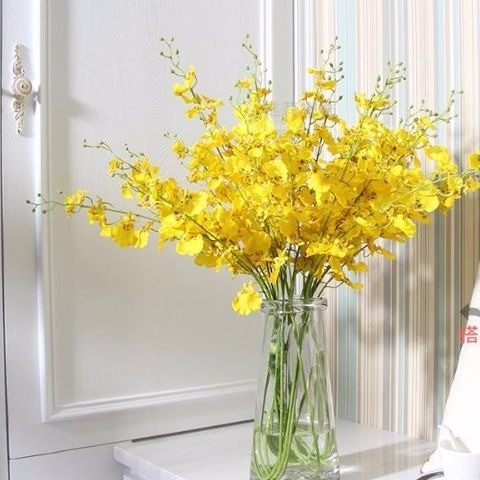 Close-up of vibrant yellow Oncidium 'Dancing Lady' orchids in bloom, showcasing their distinctive shape.
Close-up of vibrant yellow Oncidium 'Dancing Lady' orchids in bloom, showcasing their distinctive shape.
Nun’s Orchid (Phaius)
Nun’s orchids are frequently grown in clusters or clumps within pots, perfect for adding a touch of elegance to landscapes, gardens, patios, or indoor spaces. Their flowers typically have five oval petals and can bloom year-round in suitable climates. While they come in various colors, a striking purple shade is particularly common and popular for Phaius orchids.
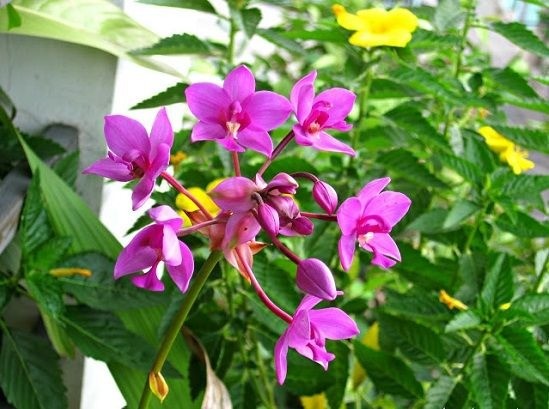 Bushy pot of purple Phaius 'Nun's' orchids with five-petaled flowers, suitable for garden decoration.
Bushy pot of purple Phaius 'Nun's' orchids with five-petaled flowers, suitable for garden decoration.
Dendrobium Orchid (Phi Điệp Tím)
This popular type of Dendrobium orchid, known in Vietnamese as “Phi Điệp Tím,” is famous for its intoxicating fragrance that captivates many. It is adaptable and can be grown successfully in various climates. While often associated with purple, blooms can range from deep violet to pinkish-purple or even white. When in full bloom, they often form beautiful cascading sprays that look luxurious and eye-catching, making them a favorite for hanging displays.
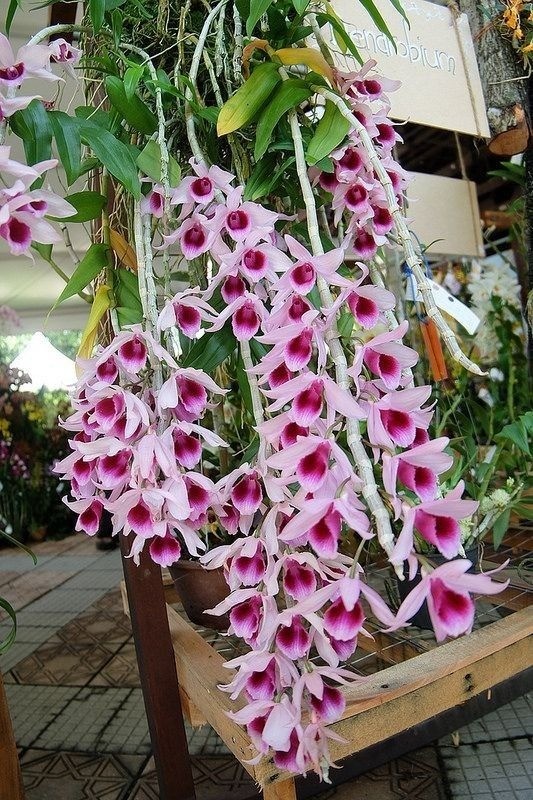 Cascading clusters of fragrant purple Dendrobium orchids (Phi Điệp Tím) hanging from a pot.
Cascading clusters of fragrant purple Dendrobium orchids (Phi Điệp Tím) hanging from a pot.
Foxtail Orchid (Rhynchostylis)
Rhynchostylis orchids, including varieties like Rhynchostylis retusa (often called “Giáng Hương Tam Bảo Sắc” or three-colored foxtail) and Rhynchostylis gigantea (Ngọc Điểm), possess a simple yet striking beauty. They produce dense, pendulous spikes of flowers that truly stand out, often accompanied by a delightful sweet fragrance. Rhynchostylis retusa is particularly notable for its blossoms that can feature three distinct colors—yellow, white, and purple or pink—on a single bloom spike, a rare and attractive trait.
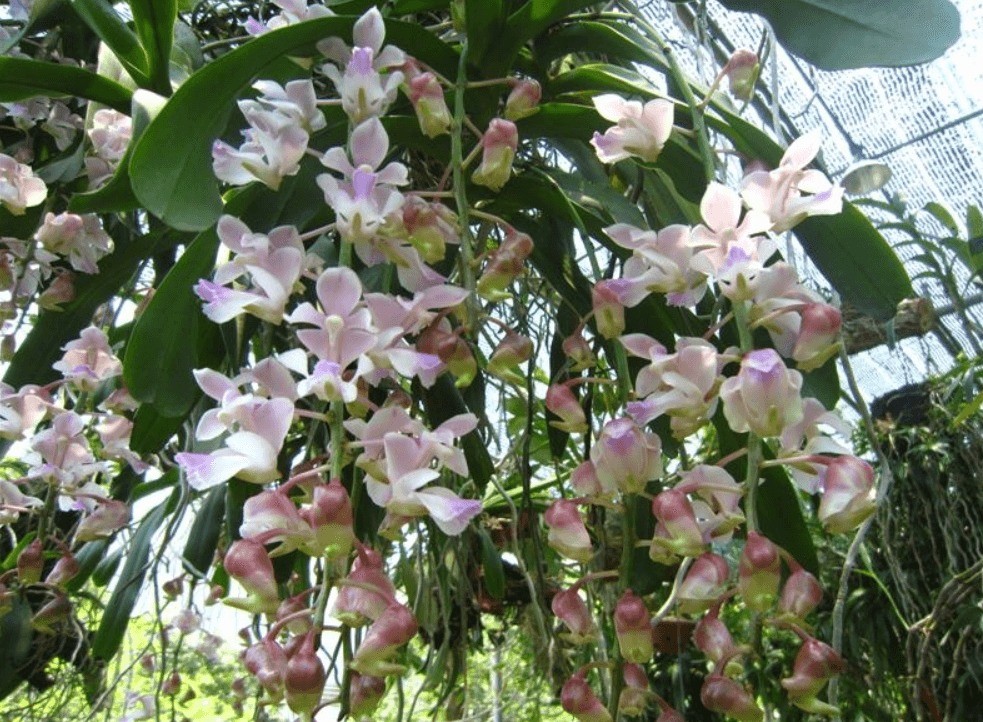 Closeup of a cluster of tri-colored Rhynchostylis 'Foxtail' orchids showing yellow, white, and pink/purple.
Closeup of a cluster of tri-colored Rhynchostylis 'Foxtail' orchids showing yellow, white, and pink/purple.
Dendrobium Orchid (Hoàng Thảo)
Dendrobium orchids, particularly those known as “Hoàng Thảo,” are increasingly popular due to their elegant beauty and wide array of colors. This diverse group offers many different species and hybrids, providing orchid lovers with countless options to admire. These orchids are known for their vigorous root systems and their characteristic growth habit of reaching upwards towards light sources, essential for their energy production and vitality.
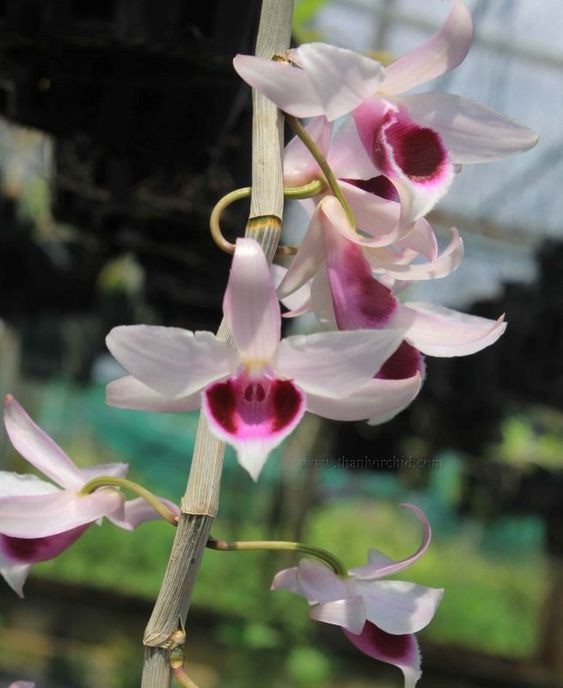 Elegant spray of colorful Dendrobium 'Hoàng Thảo' orchids with strong stems.
Elegant spray of colorful Dendrobium 'Hoàng Thảo' orchids with strong stems.
Cattleya Orchid (Cát Lan)
Cattleya orchids, sometimes referred to as “Cát Lan” or scientifically as Cattleya Labiata and its relatives, produce exceptionally beautiful flowers that are often considered the epitome of sophistication and grandeur. This is why they have earned the nickname “Queen of Orchids.” Cattleya blooms are typically very fragrant, filling the air with a rich perfume, although the individual flowers may not last as long as some other orchid types.
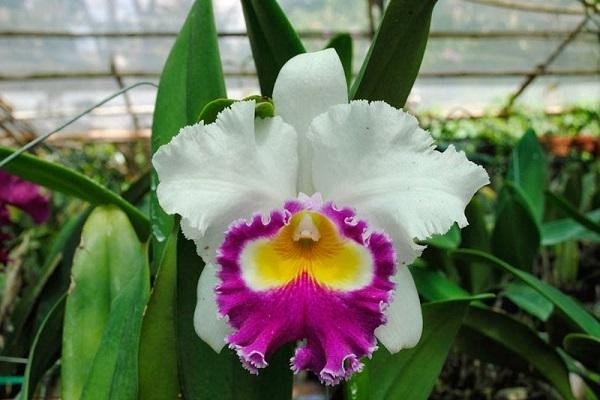 Stunning purple Cattleya orchid, often called the 'Queen of Orchids', with prominent lip.
Stunning purple Cattleya orchid, often called the 'Queen of Orchids', with prominent lip.
Foxtail Orchid (Ngọc Điểm – Rhynchostylis gigantea)
Also known by many names including “Đai Châu,” “Nghinh Xuân,” or “Lưỡi Bò,” Rhynchostylis gigantea is another type of Foxtail orchid widely found and cherished, particularly in regions like South-Central Vietnam. This species is celebrated for its dense, heavy flower clusters that present a stunning visual spectacle. The blooms come in attractive colors and emit a strong, inviting fragrance that makes them highly sought after.
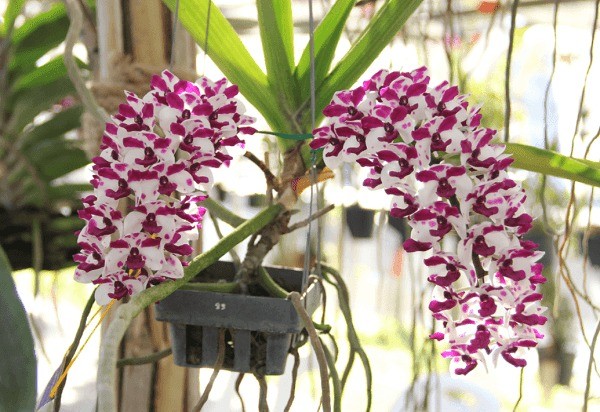 Dense, fragrant white and pink Rhynchostylis gigantea 'Foxtail' orchid spike in full bloom.
Dense, fragrant white and pink Rhynchostylis gigantea 'Foxtail' orchid spike in full bloom.
Dendrobium Orchid (Common Dendro)
Common Dendrobium hybrids, often referred to simply as “Dendro,” have origins tracing back to regions like Thailand but are now widely cultivated globally, including in Vietnam. These orchids are prized for their vast range of colors and their relative ease of care compared to some other orchid genera. They are frequently grown in baskets or mounted on pieces of wood or coconut fiber, creating beautiful hanging displays that enhance any space.
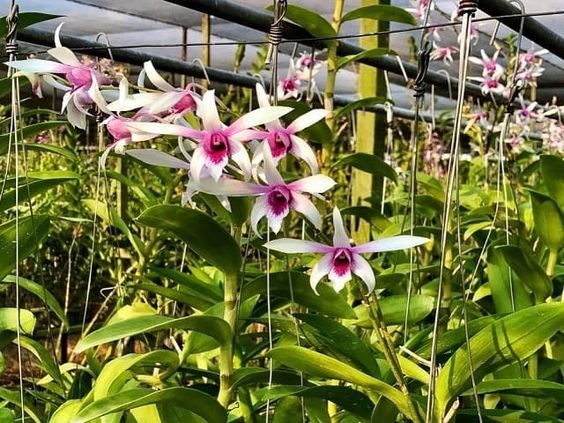 Colorful Dendrobium orchid variety, commonly grown in hanging baskets with coconut fiber.
Colorful Dendrobium orchid variety, commonly grown in hanging baskets with coconut fiber.
Moth Orchid (Phalaenopsis)
Phalaenopsis orchids, or “Hồ Điệp” in Vietnamese, are arguably the most popular and recognizable type of orchid widely available today. Their name comes from the shape of their flowers, which resemble moths or butterflies in flight, complete with colorful ‘wings’. Phalaenopsis are known for having remarkably long-lasting blooms, which can persist for several months when the plant receives proper care, making them excellent value for decorators and growers alike.
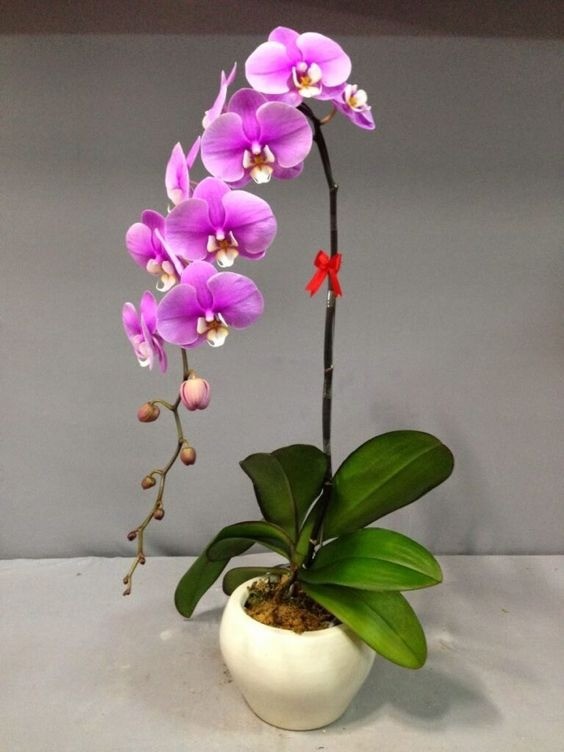 Classic white Phalaenopsis 'Moth' orchid bloom, known for its long flowering period.
Classic white Phalaenopsis 'Moth' orchid bloom, known for its long flowering period.
Essential Orchid Care Tips
Growing orchids successfully requires attention to a few key environmental factors. Understanding and managing these elements according to the specific type of orchid you are growing will help ensure healthy growth and abundant flowering.
Light Requirements
Orchids generally need bright, indirect light. Avoid placing them in direct sunlight, especially during the hottest parts of the day, as this can scorch their leaves. Dappled light, such as filtered through a curtain or from an east or west-facing window, is often ideal. Sufficient light is critical for the plant’s ability to photosynthesize and produce the energy needed for blooming.
Temperature
Most orchids thrive in temperatures between 20°C and 25°C (approximately 68°F to 77°F) during the day, with a slight drop at night. However, the ideal temperature range can vary depending on the specific orchid species or hybrid. Researching the needs of your particular orchid and observing its growth will help you determine if the temperature is suitable.
Humidity
Coming from typically humid tropical environments, orchids prefer relatively high humidity levels, ideally between 40% and 60%. In dry indoor environments, you may need to increase humidity using a humidity tray filled with pebbles and water or a room humidifier. Good air circulation is also important to prevent fungal issues in high humidity.
Watering
Proper watering is crucial, and it’s often where new growers face challenges. The frequency depends on the orchid type, potting medium, temperature, and humidity. A good rule of thumb for many common orchids is to water thoroughly once or twice a week. Allow the potting medium to dry slightly between waterings. Use clean water, and avoid letting the plant sit in standing water, which can lead to root rot. You can check moisture levels by sticking your finger into the potting mix or observing the color of the roots (often green when wet, silver when dry for epiphytic types).
Conclusion
Orchids offer a diverse and fascinating world for plant enthusiasts, ranging from the easy-going Phalaenopsis to the majestic Cattleya and the fragrant Dendrobiums. Understanding their classification and fundamental care requirements regarding light, temperature, humidity, and watering is key to nurturing these beautiful plants. By choosing a variety suited to your environment and providing consistent care, you can enjoy their stunning and often long-lasting blooms. Ready to select your next beautiful orchid or need the right supplies to help your current ones thrive? Explore the range of high-quality products and insightful resources available at Biogarden.asia to support your passion for growing these incredible flowers.



